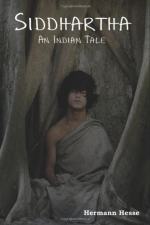|
This section contains 9,892 words (approx. 33 pages at 300 words per page) |

|
SOURCE: “Siddhartha,” in The Reception of Hermann Hesse by the Youth in the United States: A Thematic Analysis, Peter Lang, 1982, pp. 317–35.
In the following excerpt, Marrer-Tising provides an analysis of thematic elements in Siddhartha.
Siddhartha, the most ‘Indian’ of Hesse's works outwardly, is, in actuality, more Chinese in its solution; the setting of the story is Indian, the names of the characters are Indian, but, as will be demonstrated, the Chinese influence is ultimately the key to understanding the conclusion of the work as well as Hesse's intention. In a letter to Stephan Zweig, Hesse mentions Siddhartha and confirms the Chinese preponderance, writing: “Mein Heiliger ist indisch gekleidet, seine Weisheit steht aber näher bei Lao Tse als bei Gotama.”1 As Hesse outlines the plot, his protagonist, the son of a Brahman, becomes an ascetic; he then hears Buddha's teachings, which he rejects, going into the world where...
|
This section contains 9,892 words (approx. 33 pages at 300 words per page) |

|


